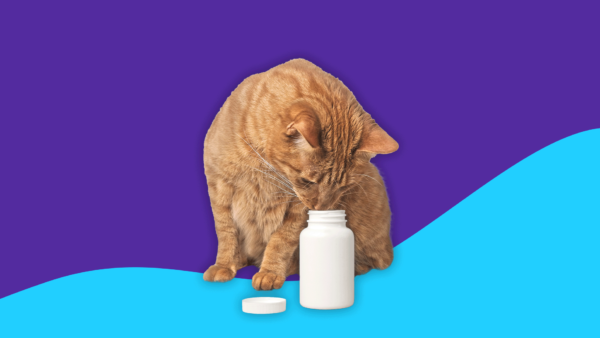Key takeaways
Meloxicam is an active ingredient in Metacam, an NSAID that treats pain and inflammation caused by osteoarthritis.
The right meloxicam dosage for a dog depends on several factors, such as weight, age, and present health conditions. Talk to a licensed veterinarian about what’s best for each particular dog.
Dogs can overdose on meloxicam, which may cause adverse effects such as vomiting, diarrhea, and lethargy. Even without an overdose, dogs may experience gastrointestinal distress.
The best way to administer meloxicam to dogs is by dropping it on their food.
Meloxicam can be stopped at any time. Just ensure the veterinarian agrees it’s safe to do so.
Meloxicam is a non-steroidal anti-inflammatory drug (NSAID) for people and some animals. It’s manufactured by Boehringer Ingelheim for animals under the brand name Metacam.
In dogs, the use of meloxicam helps control the pain and inflammation associated with osteoarthritis. Like carprofen, a similar medication, it works by inhibiting the enzymes that create prostaglandins, a compound that affects inflammation.
This U.S. Food and Drug Administration (FDA) approved medication can help big and small dogs. The dosage depends on several factors, such as the dog’s weight. Generally, dogs are prescribed anywhere from 0.02 mg to 5 mg.
RELATED: What is meloxicam used for in dogs?
Meloxicam dosage for dogs
Besides their weight, other factors affecting the proper meloxicam dosage for dogs include health conditions and age.
“Meloxicam is excreted in the urine and bile after being metabolized in the liver to an inactive form,” explains Dr. Grant Little, DVM, veterinarian expert on JustAnswer. “Patients with kidney or liver dysfunction typically need to take lower doses of it as they may not excrete it well, which can be lowering the dose by as much as 25 to 50%.”
Other dogs that may not need a full dose, he continues, are those who are “overweight,” older, or have metabolism issues.
Additionally, dog owners should use caution when giving meloxicam to dogs with a GI ulcer, bleeding, heart disease, kidney disease, or liver disease. Some medications shouldn’t be taken at the same time as meloxicam, either. “First of all, meloxicam shouldn’t be used with any other NSAIDs and with caution with steroids,” says Dr. Chryle Bonk, DVM, a veterinarian working with Dogster.com.
Contraindications for the use of meloxicam, according to DailyMed, include dogs with a known sensitivity to meloxicam. Additionally, the safety of its use hasn’t been established for dogs who are younger than 6 months, pregnant, lactating, or have bleeding disorders.
The number of days meloxicam is prescribed can vary slightly, depending on why it’s needed. “For surgical conditions, it is usually prescribed around five to seven days at a time,” states Dr. Little. However, meloxicam can be taken for much longer, though. “For chronic conditions, it may be prescribed for life depending on the condition,” Dr. Little adds.
Dr. Bonk largely agrees, saying five to 14 days is typical. He gives examples of arthritis, Shar-Pei Fever, cancer, and chronic back pain. “In these cases, dogs typically start with a higher dose on day one, and then the dose is tapered down to the lowest possible, which still provides relief,” Dr. Bonk says. By decreasing the amount in increments from the first day, veterinarians can ensure dogs get the right dose—no more, no less.
For arthritis specifically, the initial dose is typically an injection of 0.09 mg/lb, and then the daily maintenance dose of meloxicam oral suspension is 0.045mg/lb. But of course, it’s best to ask a licensed veterinarian about the dog’s specific needs.
However, even when dog owners give their dogs meloxicam as prescribed, it can cause side effects. Examples include vomiting, bloody stools, diarrhea, loss of appetite, yellowing of the eyes and gums (jaundice), itchiness, behavior changes, urinary changes, and lethargy. These may indicate that a larger concern, such as gastrointestinal bleeding, stomach ulcers, and liver or kidney problems, are also present.
Given all those potential side effects, is it okay for a dog to take meloxicam long-term? Dr. Little affirms they can do this—just be aware it can cause problems. “It can do long-term damage to internal organs such as the kidneys by reducing blood flow to the kidneys,” he says. “It is recommended to do periodic blood work and urine screenings to monitor kidney function and other organs.”
How much meloxicam can I give my dog?
While dog owners must talk to a veterinarian about the right dosage (given the many factors involved), one piece of the calculation is the dog’s body weight.
Typically, Metacam is prescribed in dogs as an oral suspension with a very precise dosing syringe.
Overdose of meloxicam in dogs
Too much meloxicam (or anti-inflammatory meds) can hurt a dog. “The main concern that arises is ulcers in the stomach,” Dr. Little says. This can lead to many serious side effects, he continues, such as intestinal bleeding, vomiting, nausea, and lack of appetite.
According to the American College of Veterinary Pharmacists (ACVP), clinical signs of meloxicam toxicity include:
- Vomiting
- Abdominal pain
- Melena (black, tarry stool)
- Diarrhea
- Weakness
- Involuntary muscle movements
- Seizures
In cases of more severe toxicity, in which GI perforation or renal failure occurs, symptoms may not arise until 48 to 72 hours after ingesting meloxicam.
Dr. Little says kidney dysfunction and eventual kidney failure can occur at higher dosages or if meloxicam is taken for a long period of time.
The signs of kidney damage, according to the ACVP, include:
- Increased thirst
- Increased urination
- Loss of appetite or refusal to eat
- Fatigue
- Vomiting
An overdose can be scary, and dog “parents” aren’t alone in handling it. “If you think your dog took too much, it is advised to seek emergency care right away,” Dr. Little says.
Dr. Bonk agrees, saying, “They will help you through the next steps as they can vary based on each situation.”
Treatment usually entails stomach protectants, fluid therapy, or other options, according to Dr. Little.
Additionally, therapeutic plasma exchange can be helpful, as evidenced in a 2017 study in the Journal of Veterinary Emergency and Critical Care.
Prevention is paramount. “It’s advised to stay on track with the dosing schedule recommended by your veterinarian for your pet, adjusting it as necessary based on your pet’s condition,” Dr. Little says.
Guidelines for administering meloxicam in dogs
Meloxicam comes in oral and intravenous formulations. Generally, veterinarians recommend giving dogs meloxicam once daily, by mouth, and in oral suspension for safe administration, says Dr. Little.
“Meloxicam comes in a pill form or a liquid dropper,” adds Dr. Bonk. “The liquid is best mixed with food while the pill can be given directly in their mouth.” DailyMed emphasizes not dropping the liquid medicine directly into the dog’s mouth.
As mentioned, the medication can cause gastrointestinal distress—but dog owners can take steps to prevent or reduce that. “Giving it with food can reduce the risk of an upset stomach,” Dr. Little says.
Dr. Bonk says higher doses and long-term use also heighten the risk of stomach problems, but veterinarians help by prescribing the most effective dose.
While meloxicam can cause stomach problems, including ulcers, nausea, vomiting, and blood in the stools or diarrhea, it’s not guaranteed to occur. “Most dogs tolerate the medication well,” Dr. Little says.
Ultimately, each dog will have a different individual response.
Knowing how long meloxicam stays in the dog’s system can be helpful. “The half-life of the drug is about 12 hours, which means after five half-lives, there will be less than 3% of it left in the body,” Dr. Little explains.
He and Dr. Bonk agree that dog owners are looking at about 24 hours for the drug to exit the dog’s system. “You will then start to see symptoms return as it’s fading from the body,” he continues.
So what happens on the other end of the spectrum, so to speak, when a pet owner forgets to give their dog a dose? Best practices say to talk to the vet; this question has no cut-and-dry, one-size-fits-all answer. However, most of the time, the answer is it’s safe to give at the next meal time, according to Dr. Little, since that’s when it’s usually taken.
“Just be sure to wait for the appropriate time interval before giving another dose,” Dr. Bonk adds. “You don’t want to double up on doses or give two doses in less than 24 hours.”
How a dog owner stores the meloxicam or Metacam oral suspension is also important for keeping the dog safe. Keep the medication in a closed container and at room temperature, away from heat, moisture, and light.
Lastly, people with dogs may wonder what stopping meloxicam for a dog may look like or when it’s the right time to discontinue use.
First, it’s important to refer to veterinarians. “If there’s a life-threatening disease being treated (autoimmune, Shar-Pei fever, etc.), then discontinuing it could be very risky and wouldn’t be advised without first consulting a veterinarian,” Dr. Little says.
According to two experts, as long as significant withdrawal symptoms haven’t been noted, meloxicam can typically be started or stopped without the necessity of a tapering-off period, as the medication is quickly eliminated from the body.
Additional information can be found on Metacam’s client information sheet. People can purchase meloxicam at a reduced cost using one of SingleCare’s free prescription discount cards.
Sources
- Meloxicam information sheet, City of Seattle (2020)
- Metacam, DailyMed (2022)
- Meloxicam, American College of Veterinary Pharmacists (2018)
- Treatment of meloxicam overdose in a dog via therapeutic plasma exchange, Journal of Veterinary Emergency and Critical Care (2017)
- Meloxicam, PubChem (2024)
- Meloxicam (oral route), Mayo Clinic (2024)
- Client information sheet for Metacam for dogs, U.S. Food & Drug Administration (2022)











